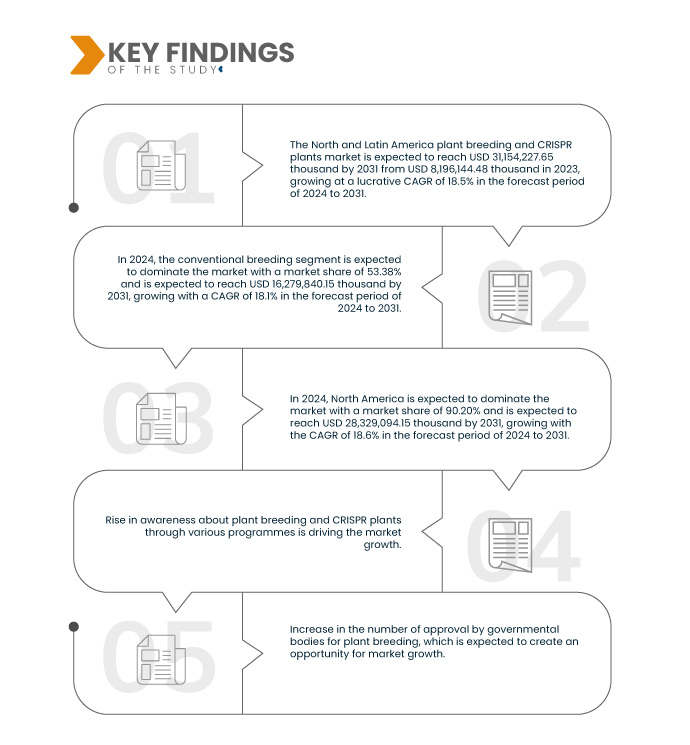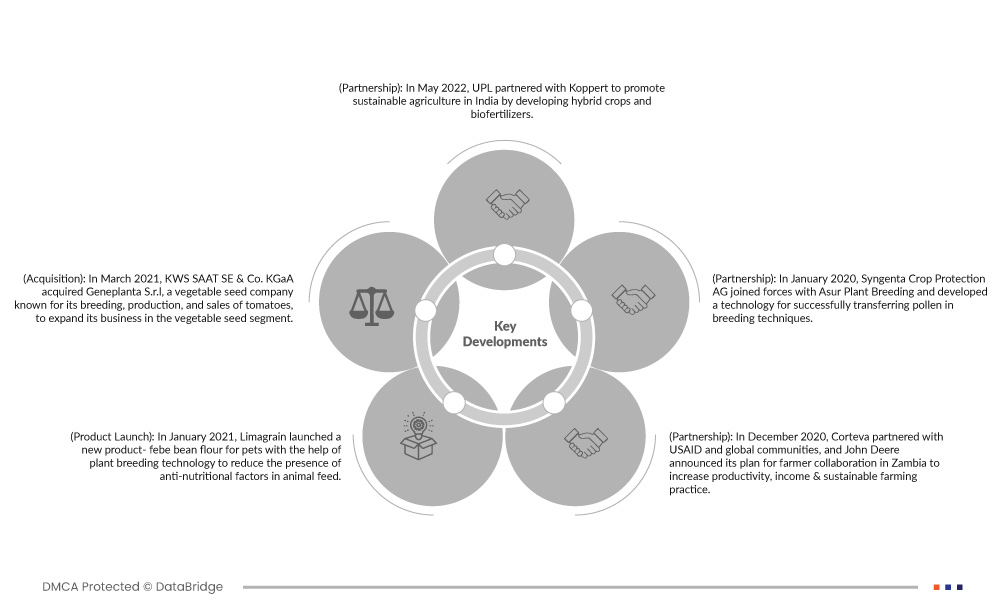Plant breeding is a technique to change the traits of plants by introducing the desired traits in the plants by targeting and transforming the DNA with extreme perfection. Plant breeding enhances crop production and improves crop nutritional quality for human or animal consumption. CRISPR is one of the main and important technologies used in plant breeding as it offers applications such as improved quality, yield, disease, and herbicide resistance. There is an increase in the R&D for plant breeding and CRISPR plants in the global region with the increase in demand for modified crops to increase yield, enhance crop quality, and reduce crop damage. The growing demand for crops or plants produced by plant breeding or CRISPR technique among farmers globally to produce high-quality crops is leading to the growth of research & development for plant breeding & CRISPR plants.
Access Full Report @ https://www.databridgemarketresearch.com/reports/north-america-and-latin-america-plant-breeding-and-crispr-plants-market
Data Bridge Market Research analyzes that the North America and Latin America Plant Breeding and CRISPR Plants Market is expected to reach USD 31,154,227.65 thousand by 2031 from USD 8,196,144.48 thousand in 2023, growing at a lucrative CAGR of 18.5% in the forecast period of 2024 to 2031.
Key Findings of the Study
Rise in Awareness about Plant Breeding and CRISPR Plants through Various Programmes
The awareness regarding plant breeding and CRISPR plants is increasing among global farmers, increasing the demand for new varieties of crops made from breeding techniques and driving the market positively. The demand for superficial or desired traits in every crop is rising among global farmers to grow the best high-yield crop with better nutritional quality. In addition, the number of programs conducted by the government regarding plant breeding & CRISPR plants is spreading awareness to global consumers and farmers.
Government-sponsored programs are crucial in disseminating knowledge about modern plant breeding techniques. In North and Latin America, agricultural departments and research agencies conduct awareness campaigns, workshops, and training sessions to educate farmers on the latest advancements in plant breeding, including the revolutionary CRISPR technology.
These initiatives aim to bridge the information gap, empowering farmers to make informed decisions about adopting innovative breeding practices that positively impact crop productivity. Moreover, collaborations between research institutions and agricultural entities facilitate the translation of scientific knowledge into practical applications. Farmers increasingly adopt CRISPR techniques in farming due to increased awareness and demand for advanced breeding technologies. Furthermore, the increasing awareness about the potential of CRISPR plants to address global food security challenges is a driving force. CRISPR allows for precise modification of plant genomes to enhance desirable traits, such as disease resistance and nutritional content. There is a heightened interest among farmers and agricultural stakeholders to leverage CRISPR techniques in their cultivation practices as awareness spreads about the role these technologies can play in ensuring food sustainability. This translates into a growing market for companies providing plant breeding and CRISPR services and technologies.
Report Scope and Market Segmentation
|
Report Metric
|
Details
|
|
Forecast Period
|
2024 to 2031
|
|
Base Year
|
2023
|
|
Historic Year
|
2022 (Customizable to 2016-2021)
|
|
Quantitative Units
|
Revenue in USD Thousand
|
|
Segments Covered
|
Type (Conventional Breeding, Biotechnological Method, and Genetic Engineering), Trait (Herbicide Tolerance, Yield Improvement, Disease Resistance, Temperature Tolerance, Grain Size Improvement, Stress Tolerance, Drought Resistance, and Others), Application (Cereal & Grains, Oilseed & Pulses, Fruits & Vegetables, Cash Crops, Turf & Ornamental, Herbs and Microgreen, Medicinal Crop, and Other Crop Types)
|
|
Countries Covered
|
U.S., Canada, Mexico, Brazil, Argentina, Colombia, Chile, and Rest of South America
|
|
Market Players Covered
|
Corteva (U.S.), Syngenta Crop Protection AG (Switzerland), Limagrain (France), KWS SAAT SE & Co. KGaA (Germany), UPL (India), BASF SE (Germany), Bayer AG (Germany), Bioceres Crop Solutions (Argentina), DLF (Denmark), DONMARIO (Argentina), InVivo (France), pairwise (U.S.), PLANASA (Spain), RAGT (France), SAKATA SEED CORPORATION (Japan), Stine Seed Company (A subsidiary of Stine Seed Farm, Inc) (U.S.), TMG Tropical Improvement & Genetics SA (Brazil), and Yield10 Bioscience, Inc. (U.S.), among others
|
|
Data Points Covered in the Report
|
In addition to the insights on market scenarios such as market value, growth rate, segmentation, geographical coverage, and major players, the market reports curated by the Data Bridge Market Research also include in-depth expert analysis, geographically represented company-wise production and capacity, network layouts of distributors and partners, detailed and updated price trend analysis and deficit analysis of supply chain and demand
|
Segment Analysis
The North America and Latin America plant breeding and CRISPR plants market is categorized into three notable segments on the basis of type, trait, and application.
- On the basis of type, the North America and Latin America plant breeding and CRISPR plants market is segmented into conventional breeding, biotechnological method, and genetic engineering
In 2024, the conventional breeding segment is expected to dominate the North America and Latin America plant breeding and CRISPR plants market
In 2024, the conventional breeding segment is expected to dominate the market with a 53.38% market share due to rise in R&D for plant breeding and CRISPR plants.
- On the basis of traits, the North America and Latin America plant breeding and CRISPR plants market is segmented into herbicides tolerance, disease resistance, yield improvement, temperature tolerance, grain size improvement, stress tolerance, drought resistance, and others
In 2024, the herbicide tolerance segment is expected to dominate the North America and Latin America plant breeding and CRISPR plants market
In 2024, the herbicide tolerance segment is expected to dominate the market with a 38.25% market share due to rising number of launches by manufacturers for plant breeding and CRISPR plants.
- On the basis of application, the market is segmented into cereals & grains, oilseeds & pulses, fruits & vegetables, cash crops, turf & ornamental, herbs and microgreens, medicinal crops, and other crop types. In 2024, the cereal & grains segment is expected to dominate the market with a market share of 26.83%
Major Players
Data Bridge Market Research analyzes Corteva (U.S.), Syngenta Crop Protection AG (Switzerland), Limagrain (France), KWS SAAT SE & Co. KGaA (Germany), and UPL (India) as the major market players in the North America and Latin America plant breeding and CRISPR plants market.
Market Developments
- In May 2022, UPL partnered with Koppert to promote sustainable agriculture in India by developing hybrid crops and biofertilizers. The partnership restored the natural balance in their crops for sustainable agriculture and achieving maximum output
- In March 2021, KWS SAAT SE & Co. KGaA acquired Geneplanta S.r.l, a vegetable seed company known for its breeding, production, and sales of tomatoes, to expand its business in the vegetable seed segment. This acquisition will help KWS SAAT SE & Co. KGaA expand its product portfolio and gain more consumers, which will help increase its revenue
- In January 2021, Limagrain launched a new product- febe bean flour for pets with the help of plant breeding technology to reduce the presence of anti-nutritional factors in animal feed. This new product launch will help Limagrain to expand its product portfolio and to attract more consumers
- In December 2020, Corteva partnered with USAID and global communities, and John Deere announced its plan for farmer collaboration in Zambia to increase productivity, income & sustainable farming practices. Agronomists from Corteva Agriscience, the company behind pannar and Pioneer Brand Seeds, will work directly with farmers to enhance the adoption of hybrid seed and crop protection technologies
- In January 2020, Syngenta Crop Protection AG joined forces with Asur Plant Breeding and developed a technology for successfully transferring pollen in breeding techniques. This partnership will help Syngenta strengthen its R&D sector, which will help attract more consumers and set a large consumer base for the company
Regional Analysis
Geographically, the countries covered in the market report are U.S., Canada, Mexico, Brazil, Argentina, Colombia, Chile, and Rest of South America.
As per Data Bridge Market Research analysis:
North America is the dominant and fastest-growing region in the North America and Latin America plant breeding and CRISPR plants market
North America is expected to dominate the market due to advanced research infrastructure, strong biotechnology expertise, and a favorable regulatory environment fostering innovation. Also, the region is expected to grow due to increasing demand for enhanced crop traits, improved agricultural productivity, and advancements in genetic engineering technologies.
For more detailed information about the North America and Latin America plant breeding and CRISPR plants market report, click here – https://www.databridgemarketresearch.com/reports/north-america-and-latin-america-plant-breeding-and-crispr-plants-market












